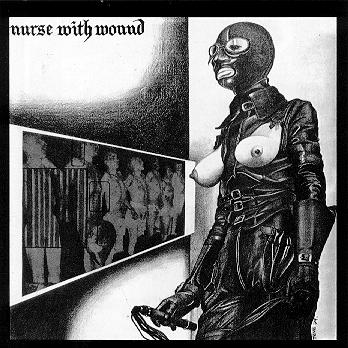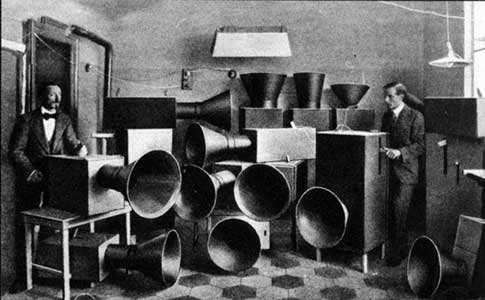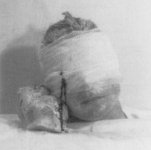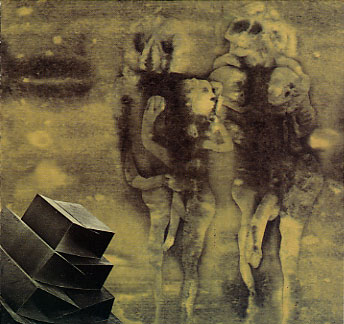Music is still fresh. A rare chance to get directly involved in the moment, an art form that is not always diluted by commercial demands. Thus, you can tell how willing people are to entertain the unusual, how neophiliac their tendencies, how they really react to the new, by checking their taste in aural excitement. The financial vagaries of the contemporary art market etiolated static art by removing it from the everyday and into the art gallery. Interactive sculpture and similar responsive arts are overwhelmed by their novelty value. Meanwhile, music still offers a chance for real emotion. It moves, just like life. Most people are still musically innocent, just don't know or can’t take the strong enjoyments on offer at the audio outside edge. And, thanks to technology, methods of musical propagation have become much more plastic, i.e. responsive to what your momentary whim might be, or your long-term plans. The last two sentences combined suggest that you can go much further with the aid of music more easily than with other artistic pursuits.
Right, that’s the pretentious opening bit over with. What has it got to do with Nurse With Wound, you say? Best to go over it step by step.
 In
1979, Steven Stapleton, Heman Pathak and John Fothergill managed to squeeze
out of their collective psyche a curious LP which encapsulated a whole
stream of acid-nihilist musical innovation from the Seventies and coupled
it with a fierce iconoclastic attitude last found circa 1905-30 (having
been kick-started by Lautreamont in the 1840s). Why on earth should this
record be in any way coherent or exciting? But it is, although not necessarily
both at the same time. "Chance Meeting on a Dissecting Table of a
Sewing Machine and an Umbrella" is an amusingly grim mixture that
suggests many things without ever actually giving the game away as to
what, just like surrealism. And, of course, it’s bloody noisy. I
still vividly remember lying in a lukewarm bath on a Sunday afternoon
in 1980 with homely, trustworthy Radio One pootling away in the background,
when a godawful screeching, wailing, moaning, banging, crunching sound
started twitching in an ill-mannered fashion from the ‘speaker. Were
the batteries going flat? No. United Dairies had just got their first
(and last) national radio plug. NWW were showing us what real noise could
be - awfully constructed, artlessly aggressive. Right from the unwieldy
length of the title through to the unwieldy length of the pieces, a refusal
to compromise was evident.
In
1979, Steven Stapleton, Heman Pathak and John Fothergill managed to squeeze
out of their collective psyche a curious LP which encapsulated a whole
stream of acid-nihilist musical innovation from the Seventies and coupled
it with a fierce iconoclastic attitude last found circa 1905-30 (having
been kick-started by Lautreamont in the 1840s). Why on earth should this
record be in any way coherent or exciting? But it is, although not necessarily
both at the same time. "Chance Meeting on a Dissecting Table of a
Sewing Machine and an Umbrella" is an amusingly grim mixture that
suggests many things without ever actually giving the game away as to
what, just like surrealism. And, of course, it’s bloody noisy. I
still vividly remember lying in a lukewarm bath on a Sunday afternoon
in 1980 with homely, trustworthy Radio One pootling away in the background,
when a godawful screeching, wailing, moaning, banging, crunching sound
started twitching in an ill-mannered fashion from the ‘speaker. Were
the batteries going flat? No. United Dairies had just got their first
(and last) national radio plug. NWW were showing us what real noise could
be - awfully constructed, artlessly aggressive. Right from the unwieldy
length of the title through to the unwieldy length of the pieces, a refusal
to compromise was evident.
Humour includes aggression. And the first five NWW albums are furiously angry. ‘Chance Meeting...’ was followed by two further excursions into the outback of angst - "To The Quiet Men To The Tiny Girl" and "MerzbiId Schwet" (note the progressively shorter titles!), both LPs with one track per side thereby affording the opportunity to get right into the nihilist groove.
There are too many cosy art galleries where you pay to stare at surrealist pictures then go home for tea. But those pictures were the result of an urgent need - a violent reaction for survival in a world suffering from an upsurge of belligerent cretinism. Of course, the Surrealists got caught in the end, drifting off into political buffoonery, but they left interesting pointers on the way. Music lagged behind Dada and Surrealism badly due to lethargy (conservatism?) and lack of technical means. Hence, the honourable mention of Luigi Russolo on "Chance Meeting...". This guy got up to all sorts of existential pranks and just loved noise. He was the first avowedly Industrial musician. (Ironically, I don’t think that NWW are industrial...) He wrote symphonies for factory sirens. He got off his arse and actually made loads of "intonomatauri" - noise machines. He loved the random mechanised cacophony of modern city life (probably the only healthy reaction when you’re actually living in the midst of it). NWW’s early music often seems composed of this detritus, turning it into streams of expressive consciousness (c.f. Kurt Schwitters’ collages made from bits of rubbish found in the street).

Luigi Russolo with the Intonorumori machines (c1914)
NOTE: we have here non-intention coupled with an aesthetic appreciation of random noise. (A paradoxically Eastern attitude for such aggressively Western artists.) Luigi Russolo was the aural precursor to NWW. The precursor. Nobody else bothered until electronic music appeared. This happened just at the time when non-intention started getting a big press. It began with John Cage (of whom Schoenberg said, "He’s not a composer, he’s an inventor, though an inventor of genius.") and continued through to groups like Fluxus in the Sixties. The pioneering work of Pierre Henry and Stockhausen seemed quite separate in spirit to Cage’s zenarchistic "accidental" music, but NWW have made a good job of combining the two musical approaches. Stockhausen and a lot of the Sixties non-intentional music was utopian and forward-looking whereas NWW live in a dystopian present, concentrating more on the "emptiness" and "blankness" of the Ying. This is why music can be soooo good - it appeals to your non-verbal right cranial hemisphere, which these days usually comes in for a right hammering at the hands of the advertising industry and blipvert culture.
Cage had no ideas about what music should be like, he just did it, in the here and now. It is important to note that there’s no political viewpoint whatsoever in his life, never mind in his music. This is a key difference to the "worthy" socialist brigade prevalent in the dull, patronising, populist Art Scene that gets all the big business sponsors.
Nonetheless, let’s give some thanks to the bourgeoisie. We’ve all seen how funny it is when you play around with "normal" art and music. Take the absurd "found voices at the end of "Ostranenie" on the "To The Quiet Men…" LP. After twenty minutes of concentrated jamming (that’s jamming as in communications channels, not mere improvisation) a host of ghostly voices from a crappy, old British film start to intrude. They sound very significant ("Why are you not at St. James’s Fields?" "I, sir, prefer to wait at Westminster." and so on).This is genuinely surreal and holds the promise of a sort of Enlightenment.
Enlightenment? Well, why not? NWW’s records have a concentrated non-intention (paradoxical, no?) which comes across strongly in their approach to instruments. They feature co-operatives of people approaching instruments as well-made machines and innocently bashing the crap out of them (more Cage influence, there). You can hear the same one sound become a meandering stream that flows through utter tedium into humour and then hypnotically draws you into a tense hyper-situation that features the sort of meaning traditionally achieved by Zen-style "direct pointing (i.e. non-verbal). After this you are in a state of heightened awareness. Noise from the street becomes orchestrated and interesting to listen to for its own sake. You cough and look out of the window, and it’s engaging.
We mustn’t forget the boredom. Some NWW pieces have a built in boredom factor. I remember various occasions when after 20 minutes of squeakiness the view out the window had got really interesting and I was frankly desperate for the boringness to stop. (This represents Eris in the Bureaucratic phase of discord, often appearing as the Filing Cabinet.) It’s the trickiest balancing act ever - to make music about boredom which includes it as an element but that still works... Or am I over-justifying lapses of inspiration? It’s a matter of taste. Work it out for yourself.
Existence itself is an unutterable mystery, an occasion for sheer panic and overriding joy (and we mustn’t forget the boredom). During the course of a NWW piece, you may well experience these poles with such confusion at hand as to (maybe) suggest the way they are joined.
Regarding Zen - it isn’t solely about mending motorcycles and arranging flowers - it has a darkly surreal streak of its own. (‘On Mount Wu-t’ai the clouds are steaming rice / Before the ancient Buddha hall, dogs piss at heaven" - The Zenrin, c.17th century.) Pick up the stone of repressive conditioning and you’ll find some very odd things underneath. Zen allowed for this and, similarly, NWW’s direct pointing portrays the things underneath. (Minimalists portray the stone.)
The un-/pre-/sub-conscious is not full of warped things by design, it just gets that way if you keep being dishonest and repressive. And so we find nameless childhood fears surfacing - e.g. "Homotopy to Marie". Side one of this, possibly the darkest NWW LP, is all childhood nightmares, dark groaning, menacing surges of metallic percussion. Very Freudian, very Victorian. Stultifying menace meets childlike, puzzled innocence. It captures something about the surreal scariness of childhood very well if we’re honest about the whole thing - it’s a strange time of irrational fears, when the ego has yet to really take hold and the Underneath is still near the surface, when we’re profoundly unaware of our powerlessness.
Take a rabbit - only about one per cent of its body mass is cute and cuddly. It is a veneer that hides yards of entrails and puffy, squishy offal. It’s a good job that the nice bit is on the outside. Well, Victorian times were a lot like that, society in general is like that, and really your mind is like that. A generally attractive, useful exterior with lots of weird wiring and piping that is necessary to keep it all going. (Anybody who has accessed this part of their mind will have been to hell - out of the light, vicious loops of alleys without end) and, in any case, meant to be hidden. You don’t dig up the roots of a tree in order to make the tree grow better.
We like to think that we have consigned our gods and demons to the rubbish bin of science and progress but something strange happened - they are now cloaked in Modernist garb but inwardly as primal as ever. (For a brilliant exposition of this idea, listen to any record by the underrated Organum.) With NWW’s earlier pieces, you confront something that seems very twentieth century European but - surprise - is from that perpetual no-time of the unconscious.
We
are now miles away from your average tomb-faced Goth pubrock guitar
"noise" 
bands. All they do is kick up a storm and then complain that they can’t
see for the dust. NWW’s music is more honest. It derives from "Actions"
- group catharsis sessions; hence, the dedication of "She Alone
Hole and Open" (from "To the Quiet Men…") to Rudolf Schwarzkogler,
who "killed himself in the name of Art by successive acts of self-mutilation".
Again, the urge for more direct expression (even if that’s not
quite a true story about Mr Schwarzkogler). The noises alone
on this track suggest that the participants were very busy with their
saws and hammers during the recording, and it suggests pain excruciatingly
well.
In general, the materials from which NWW’s music is made reflect perfectly the preoccupations of the Dadaists, Futurists and Surrealists, and the shock is vivid on hearing their ideas come to life in a late twentieth century context. It is the shock of realising that nothing is normal.
United Dairies didn’t seem that active 1983-5 and, when they returned, NWW were different. "Sylvie and Babs Hi-fi Companion" is a dopehead rampage through the Nightside of K-Tel. Tons of domestic tape loops and foolish doodling that seem deliberately self-indulgent, and none the worse for it. Who said NWW were humourless? (Of course, there is black humour everywhere with NWW and, if you don’t know that then you shouldn’t be reading this article. So, go on. Fuck off now!) Their humour reminds me of the way in which Pete Carroll put laughter at the centre of his Tree Of Life.
But then comes increasing grandiosity, increasing horror-giggle quotient. "Spiral Insana" will transport you to a schizophrenically really bad head situation and leave you gasping at the wonder, and the misery, of it all. The music first broods then implodes into phantasial "flights of ideas" that vividly suggest a link between schizophrenia, surrealism and religion. The usual "innocent" approach to instruments is combined with a similar approach to musique concrete to produce a work of intense and immense emotional power. We like to think of "schizos" as loud-mouthed, overactive loonies but, in fact, those so afflicted often become deeply quiet and withdrawn while their minds race ever faster into nether regions of complex mythological anguish. Hear "Insana" and realise that. Now apparent for the first time is an exquisite balancing of many musical elements (church organ, shakuhachi, voices, bagpipes, bowed cymbals, string synth(!), tribal drumming, found tapes, feedback, etc.) into a sustained dramatic "trip" that doesn’t let up for forty minutes. In the early Eighties, I heard various pieces on French radio by unheard-of tape musicians which captured similar atmospheres. These included composers such as Jacques Lejeune and Michel Chion. (The latter’s ‘On n’Arrete Pas le Regret’, involving as it does church organs and babies squawling and screeching, has to be heard to be believed.) There seems to be a definite influence or parallelism here. Fantastically funny. Totally horrific. There just isn’t enough of this sort of music about. (But, of course, romanticising about schizophrenia should always be tempered with compassion.)
 The
rules of the commercial art game mean that you are strictly a spectator
at the scene of established (read: expensive) art. NWW’s music
is a perfect aural representation of surrealism, giving you a chance
to experience it at first hand. Are you going to take that chance, let
them draw you in and show you? If so, you should start with "Spiral
Insana" - it doesn’t have any of those boring bits and is
colourful in the extreme (like Michel Chion’s best work).
The
rules of the commercial art game mean that you are strictly a spectator
at the scene of established (read: expensive) art. NWW’s music
is a perfect aural representation of surrealism, giving you a chance
to experience it at first hand. Are you going to take that chance, let
them draw you in and show you? If so, you should start with "Spiral
Insana" - it doesn’t have any of those boring bits and is
colourful in the extreme (like Michel Chion’s best work).
NWW continue to diversify. "Soliloquy for Lilith" shows them cooling down and becoming deeply meditative (or broody?). It is a myth that death is always an occasion for terror. This, instead, is a slide into moody but dreamy "night in the forest" atmospherics. Never before has being sinister been so wholesome. Perhaps Lilith was sexy after all? Night as the time of healing and restoration, death as the blessed relief from eternity. Aside from the way it sinks into the land of deep sleep dreams (and away from "classical" style surrealism), this LP also seems part of a new interest in sound "as a reflection of its own logic", as Glen Branca put it. Music evolved from the mystery of resonant vibration, I.e. those vibrations that occur when strings are plucked or wind blows through blow-holes - naturally occurring frequencies that are inherent to physical structures. "Soliloquy for LiIith" invokes a fascination with the subtle slowly changing notes, creaks and whispers that appear, as if by magic, in resonant systems when they are stirred into action with minimum human interference. Other composers with similar preoccupations include Giacinto Scelsi, David Jackman of Organum, and Jim Sauter and Don Dietrich of Borbetomagus. They have a common interest in creating overbearingly loud music. The fascination comes, at least partly, from the self-reflexive nature of our own consciousness.
NWW have also made some diverting twelve inch singles over the years: "Cooloorta Moon" - Benny Hill on acid, "Nil By Mouth" - more chiIdhood hospitalization/alienation scenarios, "Journey Through Cheese" - a tribute to nylon in music. (Anyone who has ever owned a pair of nylon pyjamas will understand the link between nylon and cheese.) My favourite is "A Short Dip in the Glory Hole" (side two of "Brained by Falling Masonry") - the perfect tribute to David Lynch’s earlier stuff, more Eraserhead than Eraserhead.
When are NWW going to stop? They already have - it’s been ages since they last released any new material. Steven Stapleton is now unreachable but at least "Lumbs Sister", their la(te)st LP, packs a powerful, geomantic punch. Eerie magic mushroom music for elementals with a grudge. It shows how NWW’s music has become increasingly beautiful (in a primitive fashion), while still remaining apart from the mundane and mediocre. A more stream-like flowing is evident. No more the boundless Maldororian vigour of despair found on side two of "Homotopy to Marie", no more carbonised crepuscular crunching but, instead… more light?
LINKS
Nurse With
Wound page at Brainwashed:
http://brainwashed.com/axis/nww/
Rudolf Schwarzkogler
at Axis Archive:
http://brainwashed.com/axis/schwarzkogler/rudolf.htm
The Sound
World, Instruments And Music Of
Luigi Russolo - by
Hugh Davies:
http://www.l-m-c.org.uk/texts/russolo.html
This article orginally appeared in Fractured fanzine #2, 1991. It has been revised by the author for Uncarved.